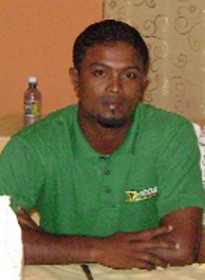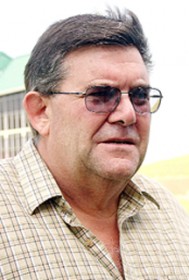Cozier on Sunday
The West Indies and Zimbabwe have simply marked time over the past three weeks.
After five limited-overs matches, they remain in their same lowly positions on the International Cricket Council (ICC) rankings and have learned little new about themselves.

The sequence was just as it was in their last encounter, two years ago in Zimbabwe, when the West Indies lost the first match before finding their land legs and taking out the next three.
Only days back from a morale-crushing hammering in Australia and in conditions more suited to the bowling strength of the opposition than their own, they have been made to fight harder this time.
Batting that variously featured the uncertain Andre Fletcher, Dave Bernard and Denesh Ramdin in the top four and unpredictability from six down has again been vulnerable to pressure.
Patience and techniques have been tested to the limit by Zimbabwe’s host of spinners on turning pitches at Providence and Arnos Vale and often found wanting.
It placed added responsibility on Chris Gayle to provide early momentum at the top of the order. More significant than his batting were his forthright comments, especially following the defeat in the first ODI.
It revealed his justifiable frustration at culpable players although more than just one might have paid for their indiscretions with their places in the team.
Amidst the struggles of others, Narsingh Deonarine finally confirmed the quality that was evident since he was a teenager.
His handling of the varied Zimbabwean spin and, above all, his level-headedness should have been an embarrassment to most of his team mates.

His impressive 82 in the second innings of the Perth Test in December, when Shivnarine Chanderpaul’s injury opened a spot for him, hinted at an overdue maturity. This was further evidence.
Sterner tests lie ahead, initially against Dale Steyn, Morne Morkel and the South Africans at Sabina, Warner Park and Kensington in June, but the signs are encouraging.
In Perth, and in this series, his solidity mirrored that of his fellow left-hander Brendan Nash whose disappearance since the Tests in Australia (in which he averaged 41) remains an unexplained mystery. And it is substance, more than style that the West Indies need at present.
Against batting even shakier than their own, and on favourable surfaces, Darren Sammy, Ravi Rampaul, Sulieman Benn, Nikita Miller and, when he returned, Dwayne Bravo confirmed themselves as serviceable bowlers in the abbreviated game.
For the longer term, beyond the World Twenty20 championship to the Test series against South Africa and in Sri Lanka in November, the worry is that Kemar Roach is the only one with the pace to knock good batsmen over.
His two 90 mph yorkers that demolished Vusi Sibanda’s off-stump (and, at Providence, bat) were classics and he wasted little time with tailenders.
Yet he needs like support and none has emerged in the continuing absence of Jerome Taylor and Fidel Edwards who remain under medical care with no reliable prognosis of when they will return.
What is more, Roach’s left ankle, an essential component in a right-arm bowler’s anatomy, needed a rest during the ODI series in Australia in last month. It wasn’t an encouraging development.
Even with him fully fit and fast, but without Taylor and Edwards, it is hard to imagine the attack going through 20 wickets in a Test on true pitches.
The same applies to Zimbabwe, if at the opposite end of the scale.
Their new dispensation arrived in the Caribbean with the stated mission that this was the first step towards their return into Test cricket. Given the conditions they encountered, they understandably opted to stack their hand with their strongest suit, spin.
Ray Price, their experienced left-armer, and captain Prosper Utseya, have excellent ODI records, Graeme Cremer showed himself to be a leg-spinner of genuine quality. The other leggie, Timycen Muruma, also impressed.
But it is unlikely that such a combination would work its way twice through Test opposition, especially given the frailty of its inexperienced batting.
It would have been more useful for them to have encountered true, hard pitches with a bias to batting, as they should be for one-day cricket, so that they could test their all-round strength. The problem is that such conditions are rare anywhere in the Caribbean.
There were no clearer examples than those at the Queen’s Park Oval, Providence and Arnos Vale in this series. They turned sharply from first ball to last, that at Arnos Vale for the fourth ODI on Friday compounded by encouraging movement off the seam.
Last year, the Bangladeshis were flabbergasted, but delighted, to find surfaces for their Tests at Arnos Vale and in Grenada that might have been custom made in Dhaka for the spin-based attack and pace-shy batsmen.
John Dyson was derisive about the standard of the pitches, match and practice, following his dismissal as coach last year.
Steve Waugh complained similarly after Australia’s 2004 series in the Caribbean. So have several others, local and foreign.
Gayle picked up the theme after the first match at Providence, if giving a slightly different twist.
He wanted the players to be “more involved” in determining venues so they wouldn’t hand the advantage to the opposition, as was the case with Zimbabwe and Bangladesh. Perhaps they would go for Sabina Park and Kensington but not many others offer what Gayle is looking for.
Whatever the causes, he noted that “our cricket continues deteriorating.”
It is a shift that is high on the list of reasons for the gradual demise of West Indian fast bowling and of batting standards.
The evidence is clear in the utter dominance of ordinary spin bowlers in the regional first-class tournament and the technical deficiencies of batsmen.
It was no coincidence that Barbados, Guyana, Jamaica and, later, Antigua once produced such an abundance of outstanding batsmen or that Barbados churned out fast bowlers by the score and Trinidad spinners.
They were all reared on pitches, at club and first-class level, that allowed them to confidently express their class. Now aspiring fast bowlers are discouraged by sluggish, poorly prepared conditions in which spinners rejoice. Batsmen approach their innings with deep suspicions of what they will find in the middle.
It is a problem that has needed urgent attention for too long. The solution may not be easy but the ICC has, in Andy Atkinson, a resident expert in these matters.
He has made frequent visits to Guyana, St. Lucia and Barbados over the past year to oversee pitch preparation for the World Twenty20 championship. Perhaps he can be seconded to the West Indies Cricket Board (WICB) for a long period to see if he can make a difference.





